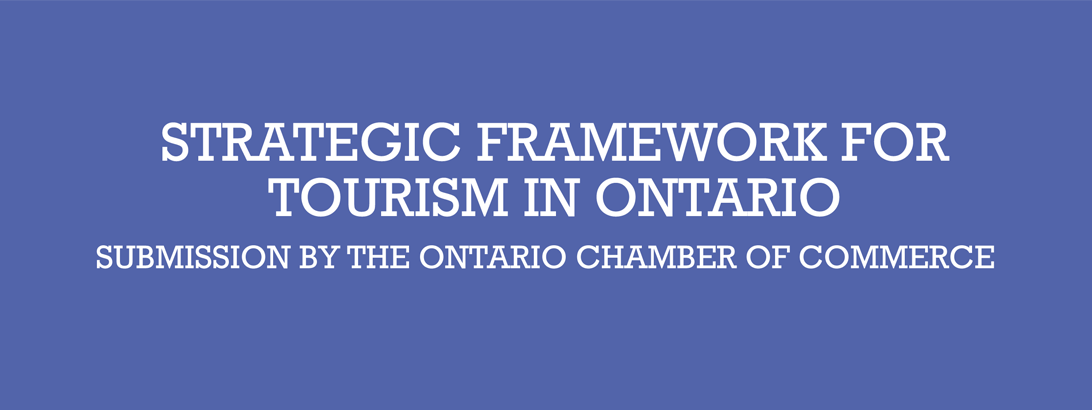Submission by the Ontario Chamber of Commerce

Minister Coteau,
Thank you for the opportunity to provide input into the development of your government’s Strategic Framework for Tourism in Ontario.
For more than a century, the Ontario Chamber of Commerce (OCC) has been the independent, non-partisan voice of Ontario business. Our mission is to support economic growth in Ontario by defending business priorities at Queen’s Park on behalf of our network’s diverse 60,000 members. We represent local chambers of commerce and boards of trade in over 135 communities across Ontario, steering public policy conversations provincially and within local communities.
Ontario’s chambers of commerce and boards of trade play an important role in the province’s tourism ecosystem. As representatives of the broader business community, this network has critical insight into the opportunities and challenges facing tourism operators in the province. In addition, many chambers/boards have played or still play a direct role in developing and promoting their own communities’ tourism offerings.
As such, we recognize that Ontario’s tourism industry is a critical economic driver in many communities across the province. In 2012, total tourism receipts exceeded $28 billion and the industry supported almost 360,000 jobs in all regions of the province. More importantly, however, we see the tourism industry’s potential for growth.
Even as uncertainty remains in the global economy, international tourism continues to grow. According to the United Nations World Tourism Organization, international arrivals increased by 4.4 percent in 2015, the sixth consecutive year of above average growth. As a result, tourism’s share of world exports increased to 7 percent, or US$1.4 trillion. With the right approach, Ontario could position itself to capture a greater proportion of the growing international tourism market.
A focused strategy to support and develop Ontario’s tourism industry is an important and necessary first step. We are therefore encouraged that the government is moving ahead with the development of this framework to position Ontario as a more competitive tourism destination.
Over the next few months, the Ontario Chamber of Commerce will be undertaking more substantive work on steps that need to be taken to grow and support tourism in the province. As a result, the chamber network will have more detailed perspectives to share at that time. However, based on some initial conversations with our membership and other members of the tourism ecosystem, we have received some initial feedback that should be considered as your government develops its final strategic framework document.
1) Where possible, steps should be taken to reduce the cumulative burden experienced by tourism operators.
To support tourism operators, it is important that the government create a regulatory environment that is conducive to business growth. A number of factors, including rising electricity rates, increases to the minimum wage, an incoming cap and trade system, a new Ontario Retirement Pension Plan, and changes to labour legislation have added to or have the potential to add to the cost of doing business in the province. These are in addition to the regulatory requirements that are currently in place that tourism operators need to comply with across ministries.
As such, burden reduction remains a priority for Ontario’s chamber network. We are encouraged by the steps that the government is taking to reduce regulatory burdens through the Red Tape Challenge. We would encourage the Ministry of Tourism, Culture and Sport to work with its colleagues in other ministries to identify opportunities for burden reduction for tourism operators.
2) Improved coordination in Ontario’s tourism ecosystem is needed, especially to maximize the impact of scarce marketing resources.
In a globally competitive tourism market, effective marketing is an essential component of tourist attraction and growth. In Ontario, marketing activities, and scarce marketing resources, are currently split among a number of different organizations, including the Ontario Tourism Marketing Partnership Corporation (OTM PC), Regional Tourism Organizations (RTO s), and Destination Marketing Organizations (DMOs), among others. At the same time, the recent decline in the value of the Canadian dollar has eroded our capacity to advertise in international tourism markets.
This underscores the need for a coordinated approach to marketing that effectively leverages our tourism marketing dollars to maximize tourist attraction. As suggested by the Tourism Industry Association of Ontario in a 2014 report, this requires clear delineation of marketing roles between different organizations to minimize duplicative or contradictory efforts. Marketing strategically should remain a key priority in the province’s final strategic framework.
3) Greater cooperation between the provincial and federal governments should be a priority.
Achieving the outcomes set out in the provincial government’s strategic framework will require cooperation and coordination with the federal government. Some policy changes that would improve the prospects for Ontario tourism, including streamlined visa requirements and more seamless border crossing, require federal action. At the same time, greater market information sharing and coordination of marketing efforts with Destination Canada could improve the reach of our advertising efforts and further grow the tourism market for Ontario. The federal government is already taking steps to market Canadian tourism opportunities internationally: Destination Canada recently launched its Connecting America marketing program and the federal budget included an additional $50 million over two years to boost advertising in important international markets. Ontario should be leveraging these initiatives to better position Canada in the world travel market with similar investments.
4) Invest in trade-enabling infrastructure to facilitate greater travel within Ontario and internationally.
The provincial and federal governments are currently moving ahead with substantial investments in infrastructure. Investing in trade-enabling infrastructure, such as airports, roads, bridges, and ports will be critical to support and facilitate greater travel within Ontario and internationally. These investments will improve access to Ontario’s tourism offerings. They will also make tourism destinations more accessible for the industry’s employees, especially in rural and northern Ontario. We encourage your Ministry to, where possible, link the final strategic framework to the province’s ongoing infrastructure investment plans.
5) Outcomes of the strategic framework should be clearly defined and monitored.
To accurately measure and monitor the success of the province’s strategic framework, the framework needs to clearly define the outcomes that it aspires to achieve. The government’s preliminary framework does identify a set of desired outcomes, including increasing tourism receipts, visitor spending, and length of stay. As currently defined, however, these outcomes are vague. For example, how much do we want tourism receipts to increase by? How much longer do we want visitors to stay? By when do we want these increases to happen? Without specific, quantifiable targets, it will be very difficult in the future to evaluate just how successful the strategic framework has been. We encourage the government to consider more clearly defining and quantifying its desired outcomes.
The Ontario Chamber of Commerce believes that supporting Ontario tourism is critical to the province’s long-term economic growth and prosperity. As your government moves to finalize and implement its strategic framework for tourism, we encourage you to work with the chamber network and the broader business community to foster the growth of the tourism industry.
As a next step, I would appreciate an opportunity to meet with yourself or your staff to discuss our upcoming tourism project and how we can work together towards our common goals.
Sincerely,

Allan O’Dette,
President and CEO
Ontario Chamber of Commerce
About the Ontario Chamber of Commerce
For more than a century, the Ontario Chamber of Commerce (OCC) has been the independent, non-partisan voice of Ontario business. Our mission is to support economic growth in Ontario by defending business priorities at Queen’s Park on behalf of our network’s diverse 60,000 members.
From innovative SMEs to established multi-national corporations and industry associations, the OCC is committed to working with our members to improve business competitiveness across all sectors. We represent local chambers of commerce and boards of trade in over 135 communities across Ontario, steering public policy conversations provincially and within local communities. Through our focused programs and services, we enable companies to grow at home and in export markets.
The OCC provides exclusive support, networking opportunities, and access to innovative insight and analysis for our members. Through our export programs, we have approved over 1,300 applications, and companies have reported results of over $250 million in export sales.
The OCC is Ontario’s business advocate.



